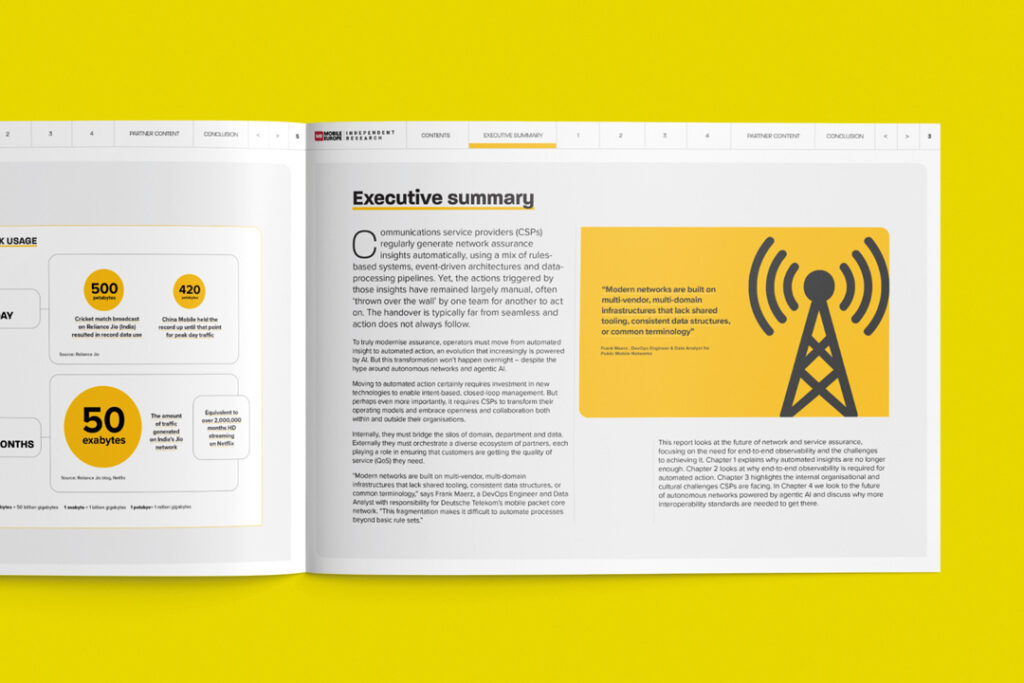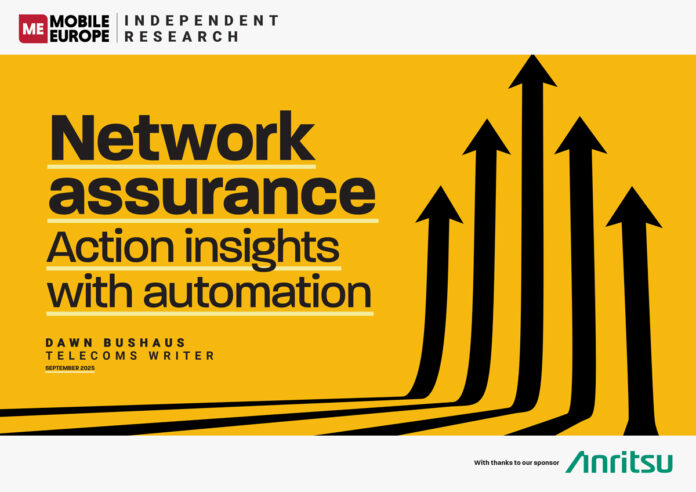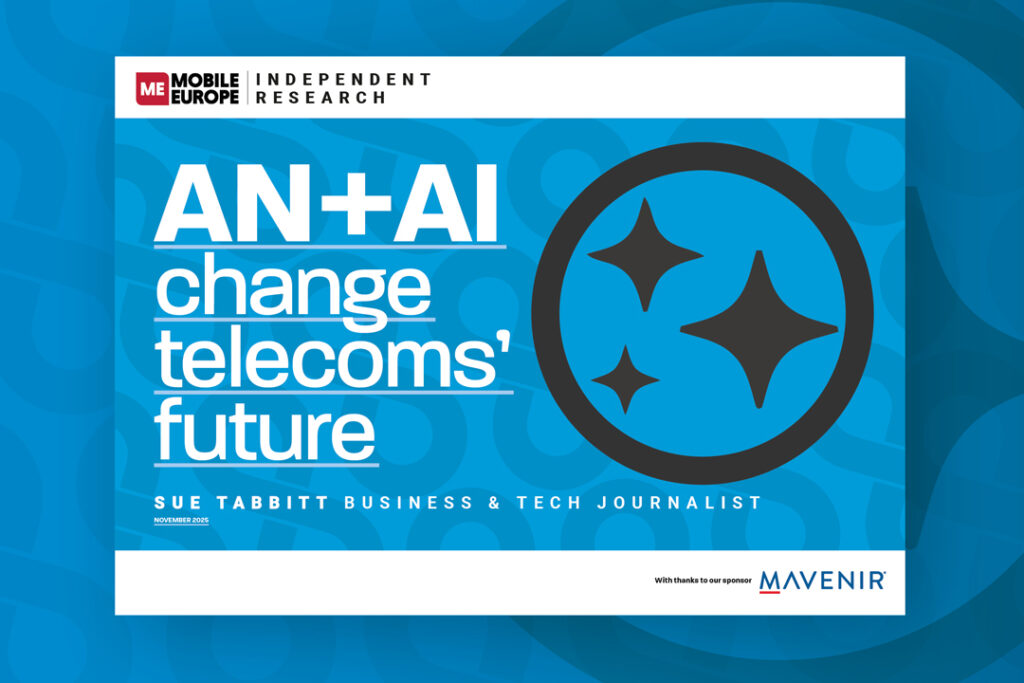“Assurance is one of the most important processes in the network,” said Telefónica’s Seccomandi David in an interview for Mobile Europe‘s new research report
Telefónica launched its Autonomous Network Journey (ANJ) programme in 2021. Today, the company is evaluating hundreds of AN use cases and has achieved Level 4 AN (see graphic below) in key scenarios in Germany and Brazil.
“Assurance is one of the most important processes in the network,” says Nilmar Seccomandi David, Director of Autonomous Network and Infrastructure in the Global CTIO Unit of Telefónica. “We are implementing a customer-centred model, where network KPIs are correlated with user metrics. This requires breaking down silos.”

Telefónica’s ANJ programme is driven by requirements to increase network autonomy, to improve customer experience, cut operating costs and ensure network quality from a regulatory perspective. The company is taking an integrated approach, with a holistic view of the entire service lifecycle from network planning through to deployment, assurance and optimisation across all network domains (radio access, IP, core, telco cloud and fixed access networks).
The programme is group-led with input from its three main operating companies in Spain, Germany and Brazil. There are four key dimensions of Telefónica’s ANJ program:
· Driving technology transformation to replace legacy networks – the company has already decommissioned its copper network in Spain and is working to switch it off in Brazil, for example, and it is implementing network functions virtualization and cloud-native network functions.
· Transforming operations support systems and consolidating data – Telefónica is focusing on OSS first in its efforts to modernise data architecture, beginning with inventory and assurance data.
· Adapting processes to eliminate the departmental silos that exist in network planning and operations – here, too, converging data is key to being able to manage intent across multiple domains and enabling process agility as automation is introduced.
· Redefining skills to implement new ways of working such as DevOps – “We have been focusing on people since the beginning,” says Seccomandi David. As Telefónica automates one process, people are reskilled for roles in other processes that haven’t yet been automated.
Measuring autonomy
Autonomy is the main metric Telefónica uses to gauge progress which is assessed based on TM Forum’s six-step AN Level methodology (see graphic below). But Seccomandi David cautions that advancing through the levels is not a linear process, and “getting from Level 1 to Level 3 is faster than getting from Level 3 to 4.”

Source: TM Forum
Four years ago, Telefónica assessed its AN level to be an average of 1.2 across domains and processes. “Now we are close to 3 on average,” Seccomandi David says, explaining that some operating companies are achieving Level 4 in specific use cases.
Progress in Germany
In Germany, for example, Telefónica O2 has implemented a Level 4 AN framework using a network digital twin called NetOptimizer, which maps the status of its 28,000 mobile network sites and transport routes in real time. NetOptimizer enables the simulation of different configurations and virtual performance optimization before implementing changes in the physical network.
Automation of repetitive tasks and less manual intervention mean that engineers are spending 80% less time on analysis in network planning, operations and optimisation. In addition, fewer human errors in network configuration and management has reduced capacity issues in the transport network by about 40%.
Successes in Brazil
In Brazil, its Vivo branded opco has adopted AI-enabled self-healing in its 5G core network, using closed-loop automation and intent-based networking. The system autonomously detects and resolves anomalies (primarily in virtual machine performance) without any human intervention. Since deployment, Vivo has reduced the average mean time to repair (MTTR) by 30 minutes.
Also at Vivo, the company’s Fractal Project is automating the network capacity creation process. Fractal uses intent-based management, which allows technicians to define objectives, requirements and constraints at a high level. Fractal then autonomously translates the inputs into actions, executing the requested intent while managing the complexity, variety and heterogeneity of the network. This approach has cut planning time from 60 days to less than a week.
Level 4 across the board?
Seccomandi David believes it will take another three to five years for Telefónica to get to Level 4 in all domains and all processes across operating companies. When that happens, the company envisions operating “dark” network operations centers (NOCs), but there will be a transitional period during which NOC engineers will continue deploying AN use cases powered by AI to evaluate whether they can be scaled.
Today, Telefónica has implemented about 400 AN use cases, many of them using AI, though the number of agentic AI use cases so far is small. That said, several other use cases did not progress beyond the testing phase because of cost-related constraints. “It can be so expensive to implement the use cases,” Seccomandi David says. “In some cases, you can spend €1 million to implement a use case, but the benefit might be just €50,000. We can’t justify that.”
A need for network standards
A major challenge for Telefónica and other operators in implementing ANs is a lack of standardisation across vendors and platforms. For example, many vendors that Seccomandi David meets cannot tell him what their level of autonomy is for their solutions.
In June, TM Forum launched a new service called Autonomous Network Level Assessment Validation (ANLAV), enabling CSPs to independently verify their level of network autonomy. ANLAV builds on the Autonomous Network Level Evaluation Tool (ANLET), introduced last year to help CSPs benchmark their automation maturity and track progress toward Level 4 autonomy in key network domains and processes including RAN and core fault management, IP network optimisation and fault management, change management, network planning, and energy efficiency. So far, about 30 operators have completed evaluations.
Vendors need to join in
“Operators are measuring autonomy, but vendors are not,” Seccomandi David says, adding that he would like to see an AN-level assessment for suppliers. It may also be useful for TM Forum to develop and certify network components in the Open Digital Architecture (ODA), similar to the OSS/BSS components the group is developing, he says.
Other telco executives agree. For example, Telstra’s Shalin Sehgal, Group Executive, Global Networks and Technology, said he would like to see TM Forum actively recruit more network engineers to collaborate on developing ODA network components.
To find out about more about next steps in automation and assurance, download Mobile Europe’s new report now.





